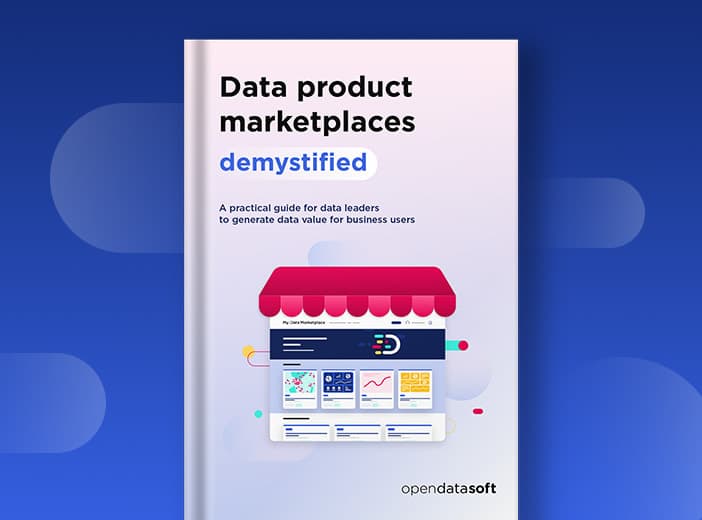What is the difference between a data product and a data asset?
Data products and data assets both aim to make data usable and valuable. What are the differences between the two and how do you incorporate them into your data strategy?

Organizations are generating growing volumes of data – but on its own this raw data may not deliver value. It can be difficult to interpret, in the wrong formats or simply be too basic to be useful. That’s why there’s a growing requirement to turn data into more accessible and valuable data assets and data products. But what are the differences between the two and how do you incorporate them into your data strategy?
What is a data asset?
A data asset is any digital object or entity made up of data that delivers some sort of value. It could be a tabular dataset, a data visualization (such as a dashboard) or a data service. Essentially a data asset is the next step on from raw data, enriching and organizing it so that it can be understood and used. For example, raw data from a sensor that takes a reading every minute will simply be a large table of figures – turning it into an interactive dashboard, reformatting and explaining it, or enriching with additional data (such as weather readings) turns it into a data asset.
Data assets are therefore extremely powerful and valuable. Data as an asset needs to be managed as effectively as any other company asset, such as buildings or equipment. That requires organizations to put in place an effective strategy to collect data, turn it into assets and make it available across the company and its ecosystem, such as with partners and the general public. Data assets can include everything from customer data, sales data, sensor data, survey/census data, financial data, such as budgets and accounts, and web and social media data.
How do you maximize value from your data assets?
Given the volume and variety of data that every organization creates and collects, they need to put in place an effective strategy to turn raw information into data assets, covering four areas around data asset management:
Data strategy
Given the amount of information being generated, it is impossible to turn every raw data source into a data asset. Teams need to prioritize, based on the most useful data that will deliver greatest value and help achieve corporate objectives.
Data protection
Companies need to keep their data secure and protected in line with regulations such as the GDPR and CCPA. They have to ensure that confidential and personal information is stored securely and only available to those that need it, with policies in place to enforce compliance.
Data governance
To deliver value, data assets have to be reliable and trustworthy. The underlying data must be accurate, up-to-date and follow corporate guidelines. Organizational data governance programs are therefore essential to setting and policing standards around data to ensure that it can be relied upon.
Data management
Data assets have to be available to everyone that will benefit from them. That means that organizations must put in place effective end-to-end data management processes to collect and enrich raw data, turn it into data assets and then share it securely across the business, such as through a data marketplace or data portal. As part of this they need to create a comprehensive data asset inventory to give a complete picture of all their data assets.
What is a data product?
As the name suggests, a data product is a product built around data. It contains everything someone needs to complete a specific task or objective using that underlying data. So as well as the data asset itself, it should include an interface to access the data, tools to manipulate or visualize information and descriptive metadata to explain what it contains. It should be consumable without requiring any technical skills from the end user, and meet a specific, ongoing need that they have.
Data products fall into three categories:
- Data services, such as interactive dashboards or apps built on data. Often, these data as a product services are monetized and sold to partners or customers, generating additional revenues.
- Existing products enhanced through data. For example, a smart watch collects and productizes sensor data to provide added value on health and exercise to the wearer.
- Data insights, based on ongoing analysis of data. Products in this category include recommendation engines on social media or e-commerce websites that use data to deliver insights to consumers.
How do you create a data product strategy?
Building a data product requires resources in order to identify the necessary data assets, add the interface and metadata to make them usable, and to manage it on an ongoing basis to ensure it remains up-to-date and accessible. This means they should be developed to meet a specific, ongoing business need – creating them for a one-off requirement is not cost-effective.
To maximize efficiency organizations should create an ongoing data product management strategy that reuses processes and infrastructure and standardizes development. Just as products are built in a factory, so data products should be created through established product data management processes. This reduces the time and effort needed for data product managers to create them and ensures they meet corporate data guidelines and the needs of users.
Data products and data mesh
Data mesh is an enterprise data architecture that focuses on creating a distributed, decentralized way of dealing with data. One of its key goals is to turn data into value by making it as straightforward as possible to create data products, allowing data to be consumed at scale across the organization and beyond.
However, while data products are one of the four foundational pillars of data mesh, data products themselves can be developed independently of the architecture.
What are the differences between data assets and data products?
Both data assets and data products aim to make data more accessible and consumable across the organization. While they have the same objectives, there are four main differences between them:
- Sophistication. A data product is a package of data assets, tools and interfaces, making it easily usable. It provides a complete solution, built on data assets.
- Business focus. A data product is designed to meet a specific business need, such as a monitoring dashboard that combines multiple data assets or has been created to be sold to customers.
- Ongoing need. Data assets can be created on an ad-hoc basis to meet a one-off requirement. By contrast, data products are an ongoing solution, designed to be used and supported over a longer period.
- Processes. Data products are built using standardized processes in order to maximize efficiency. While they follow corporate data governance rules, data assets can be created on a project basis to meet individual needs.
Essentially data products are the next step from data assets, creating applications or solutions that are built on a combination of data assets, business needs and the required tools, interface and metadata to make data available to non-specialists. To become data-driven, organizations need to create both data assets and data products, and share them effectively and securely across the business and with external partners and customers. A data marketplace or data portal provides a centralized way of sharing data assets and data products across the organization, with all types of user, maximizing its value, industrializing data use and accelerating data democratization.
Want to find out more about accelerating your data strategy through a data marketplace? Contact us to book a demo of our solution.




